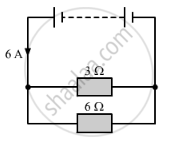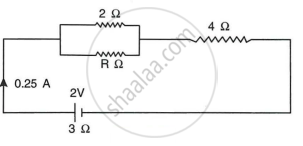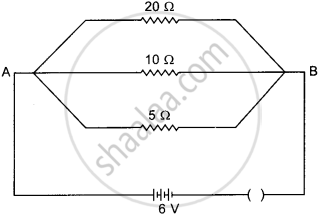Advertisements
Advertisements
प्रश्न
A piece of wire having a resistance R is cut into five equal parts.
- How will the resistance of each part of the wire change compared with the original resistance?
- If the five parts of the wire are placed in parallel, how will the resistance of the combination change?
- What will be ratio of the effective resistance in series connection to that of the parallel connection?
उत्तर
- Consider a piece of wire having resistance R. It cut into 5 equal parts. So number of equal resistros are 5. n = 5
When ‘n’ resistors of equal resistance R are connected in series, the equivalent resistance is ‘nR’
RS = nR
⇒ RS = 5R
⇒ R = \(\frac{\mathrm{R}_{\mathrm{s}}}{5}\)
⇒ R = 0.2 RS
Each part of resistance ‘R’ is equal to 0.2 times of original resistance. - Effective Resistance of 5 Resistors
`1/"R"_"P" = 1/"R" + 1/"R" + 1/"R" + 1/"R" + 1/"R" = 5/"R"`
`"R"_"P" = "R"/5` = 0.2 R - Effective resistance of series combination RS = 5R
Effective resistance of parallel combination
`"R"_"P" = "R"/5`
The ratio of series connection to the parallel connection
`"R"_"S"/"R"_"P" = (5"R")/("R"//"S")`
(2) (9 - R2 - + R2) = (9 - R2)R2
`"R"_"S"/"R"_"P" = 5 "R" xx 5/"R" = 25`
RS : RP = 25 : 1
APPEARS IN
संबंधित प्रश्न
Show how would you join three resistors, each of resistance 9 Ω so that the equivalent resistance of the combination is
1) 13.5
2) 6 Ω
In the circuit given below:

(a) What is the combined resistance?
(b) What is the p.d. across the combined resistor?
(c) What is the p.d. across the 3 Ω resistor?
(d) What is the current in the 3 Ω resistor?
(e) What is the current in the 6 Ω resistor?
How will you connect three resistors of 2 Ω, 3 Ω and 5 Ω respectively so as to obtain a resultant of 2.5 Ω? Draw the diagram to show the arrangement.
How will you connect three resistors of resistances 2 Ω, 3 Ω, and 6 Ω to obtain a total resistance of 4 Ω, and 1 Ω?
You have three resistors of values 2Ω, 3Ω and 5Ω. How will you join them so that the total resistance is less than 1Ω? Draw diagram and find the total resistance.
Tick (✓) the correct choice among the following :
Consider two cases of two parallel current carrying conductors. Current in
th e same direction and currents in th e opposi te directions will produce
A cell supplies a current of 1.2 A through two 2Ω resistors connected in parallel. When the resistors are connected in series, if supplies a current of 0.4 A. Calculate the internal resistance and e.m.f of the cell.
The circuit diagram Fig shows three resistors 2 Ω, 4 Ω and R Ω connected to a battery of e.m.f. 2 V and internal resistance 3 Ω. If main current of 0.25 A flows through the circuit, find:

- the p.d. across the 4 Ω resistor,
- the p.d. across the internal resistance of the cell,
- the p.d. across the R Ω or 2 Ω resistors
- the value of R.
Calculate the current flows through the 10 Ω resistor in the following circuit.

Four resistors each of resistance 5 Ω are connected in parallel. What is the effective resistance?
